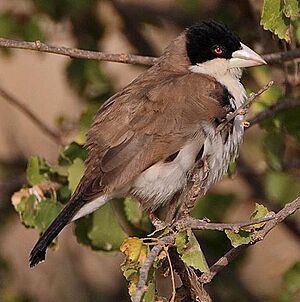Black-capped social weaver facts for kids
Quick facts for kids Black-capped social weaver |
|
|---|---|
 |
|
| Conservation status | |
| Scientific classification | |
| Synonyms | |
|
The black-capped social weaver (Pseudonigrita cabanisi) is a small, sparrow-like bird. It belongs to the weaverbird family. These birds are known for building amazing nests.
Adult black-capped social weavers have a big black cap on their head. They have an ivory-colored beak and bright red eyes. Their back and wings are brown, and their tail is blackish-brown. Their throat and belly are white, with a black line down the middle. Their legs are dark. These birds live in groups and build roofed nests in thorny trees. They are found in parts of Ethiopia, Kenya, Somalia, and Tanzania. Sometimes, people keep and breed them as pets.
Contents
How It Got Its Name
In 1884, a German explorer named Gustav Fischer and a German bird expert named Anton Reichenow first described this bird. They called it Nigrita cabanisi. Later, Reichenow decided it was more like a weaverbird. So, he put it in a new group called Pseudonigrita. This is why its scientific name is Pseudonigrita cabanisi. The name cabanisi honors Jean Cabanis, another German bird expert.
The official name for this bird is "black-capped social weaver." You might also hear it called "Cabanis's social waxbill" or "black-headed sociable weaver."
What It Looks Like
The black-capped social weaver is about 13 cm (5.1 in) long. It weighs between 18–24 g (0.63–0.85 oz).
Adult birds have a clear black cap that covers their head from their beak to the back of their neck. This black cap also goes around their eyes and ears. Their neck, back, wings, and rump are a smooth brown color. Their tail is dark brown, almost black. The throat, sides of the neck, chest, belly, and bottom are white. There is a thin, clear black line that runs down the middle of their belly. They have dark legs and an ivory-colored beak. Their eyes are a bright red.
Young birds look a bit different. They don't have the black markings. Instead, those parts are the same brownish color as their back and wings. Young birds have a horn-colored beak and dark brown eyes.
Where It Lives
You can find the black-capped social weaver in central and southern Ethiopia, most of Kenya, a small part of Somalia, and northern Tanzania. These birds like dry areas called savannas. They especially like places with lots of acacia trees and other thorny bushes.
How It Lives
Black-capped social weavers usually have one partner for life. They live and breed in colonies, which means many families live close together. They mostly eat grass seeds. They also eat juicy plants to get water and insects, especially when they need to feed their babies.
Building Nests and Raising Young
These birds love to build their nests in Acacia trees, Delonix trees, and Euphorbia plants. Both the male and female birds work together to build their nests. They make roofed nests from straight grass straws. These nests hang from thin branches. Each nest has two entrances that face downwards. Once the eggs are laid, one entrance is closed until the baby birds are ready to leave the nest.
A female bird usually lays two to four eggs. The eggs are about 19 mm (0.75 in) long and 14 mm (0.55 in) wide. They can be white or pinkish, with brown or purple spots.
Keeping Them as Pets
Some people who love birds keep and breed black-capped social weavers as pets. It's best to keep them in a large space with other black-capped social weavers. They do well in bigger groups. They are also quite friendly and can sometimes live with other types of birds.
If you keep them, you should provide hanging branches for them to build their nests. You also need to give them lots of nesting materials. This includes grass straws, very thin twigs, or coconut fiber.
Their main food is seeds, but they also need some insects. In the wild, they eat flowers, leaves, and fruits to get water. As pets, you can give them things like cucumber and lettuce. When they are raising chicks, they need live insects, insect paste, or shredded egg to help the babies grow strong. They also need fine grit and calcium sources, like shell grit or cuttlebone.
Sometimes, male birds might throw chicks out of the nest. Giving them small crickets instead of mealworms might help stop this behavior.
Images for kids




